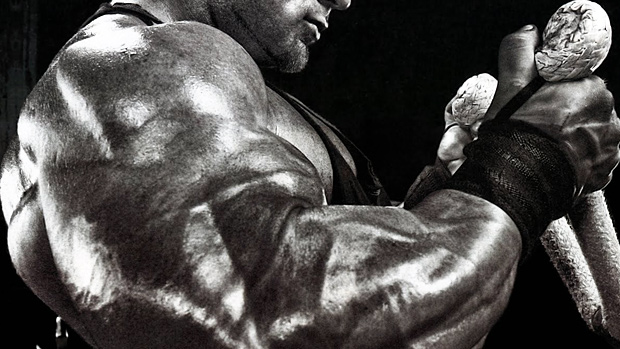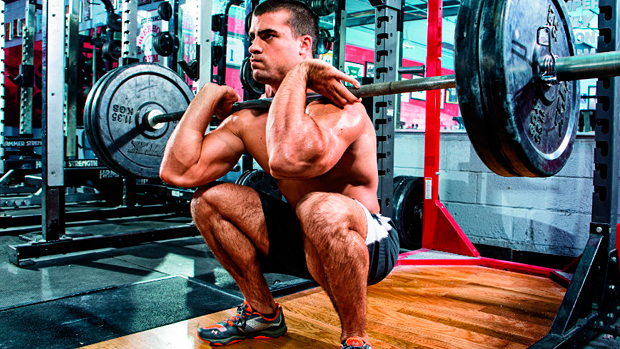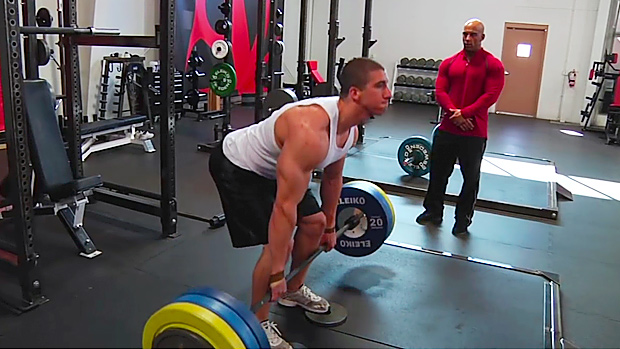You can either work hard or you can work long, but you really can't do both. At least not consistently. Here are a couple of set-extending methods that are highly productive for inducing both pain and muscle hypertrophy. (Those often go hand in hand.)
Once you've begun your first working set, take it to failure. Then rest for 20 seconds and go back at it. Once you hit failure, rest 20 seconds again and go back for one more round.
You're basically smashing in three working sets in a short timeframe. If you're keeping track in a logbook, or trying to break rep PR's, then try to get more reps in across the board each week than you did before.
For example, if you did dumbbell bench press with the 100's and got 14 reps, 8 reps, and 5 reps respectively (across the rest/pause sets), then that's a total of 27 reps. The next time you ante up for that movement, beat 27.
There are some movements I don't like with rest/pause, like squats and deadlifts. The low back is going to take a beating. Use straight sets for them. With deadlifts, never hit failure for any reason. There's just no need for it since it's too recovery-intrusive.
Try the 8/8/8 method or the 6/12/20 method. Here's how to do them...
The 8/8/8 drop set is a set of 8 to failure, followed by a decrease in weight using a poundage that allows a successive set of 8, followed by another drop in weight that allows a final set of 8. (Just don't drop the weight so low that you could've done 15 reps each time.)
With the 6/12/20 method, do 6 reps to failure, then a drop to a weight that allows for a set of 12 (performed to failure), then a final drop of 20 reps.
One method isn't really "better" than the other. The best one for you will be the one you use with the most intensity on a consistent basis.
Most often, supersets are done using a single-joint exercise combined with a compound/multi-joint movement. With compound supersets you'll be – hold on to your horses – using two compound movements back-to-back.
This isn't unusual when you're pairing antagonist muscle groups, like chest (pushing) and back (pulling). But, believe it or not, there's no rule saying you can't obliterate a muscle using two compound movements back-to-back for it. For example...
- Leg Press and Squat
- Incline Dumbbell Press and Dip
- Chin-Up and Lat Pulldown
- Overhead Press and Upright Row
If you're using one of the splits above where you're hitting one muscle group for the day, then these same-muscle pairings are awesome. But in the 3-days a week split these will work great for super-setting chest and back, quads and hams, and biceps and triceps as well. For example...
- Bench Press and Chin-Up
- Leg Press and Lunge (a glute destroyer)
- Tricep Dip and Supinated Grip Chin-Up
- Giant Sets/Circuit Work
Do a whole slew of exercises in a row with no rest until all movements are completed. I like these more using single-joint movements rather than smashing in a bunch of compound movements. You can create a really bad-ass metabolic stress session for certain muscle groups without impacting your recovery on the bigger lifts.
Use a single-joint exercise for a muscle group before moving on to a multi-joint exercise for that same muscle group. The idea behind it is that all compound movements have a "weak link" in the musculature that keeps the primary muscle you're trying to work from getting blasted as hard as it could.
For example, with squats the low back will take a fairly solid beating while the quads could actually handle more work. When you use pre-exhaustion you level the playing field by starting with leg extensions then immediately moving to a set of squats. Theoretically, the quads are now fatigued and the low back isn't the "weak link" in the kinetic chain.
Other examples would be flyes before bench or incline press, lateral raises before overhead pressing, and pullovers before chins or rows. This is a great method to really smash the living hell out of a body part in short order.





